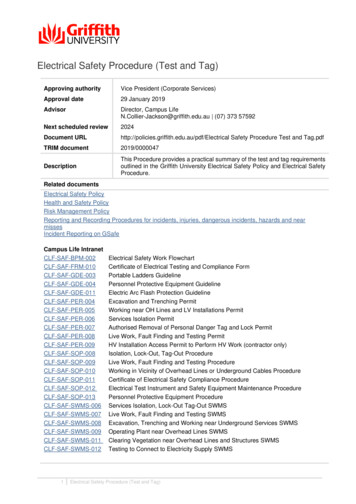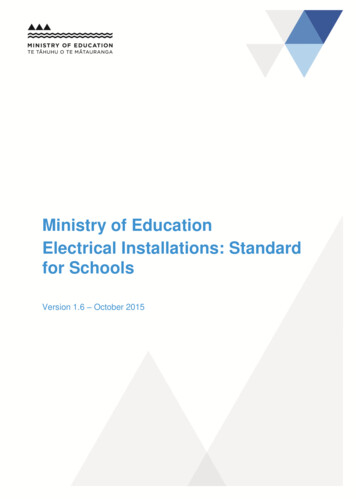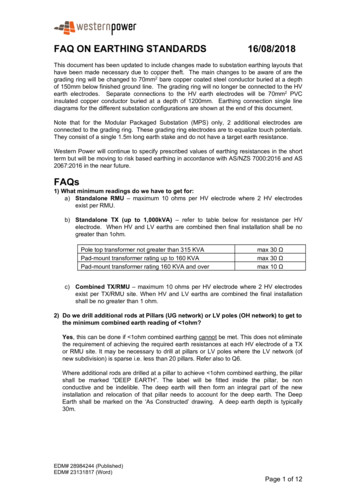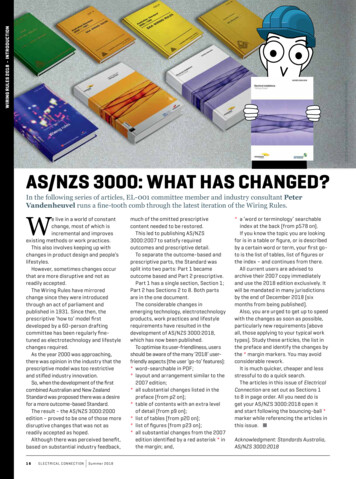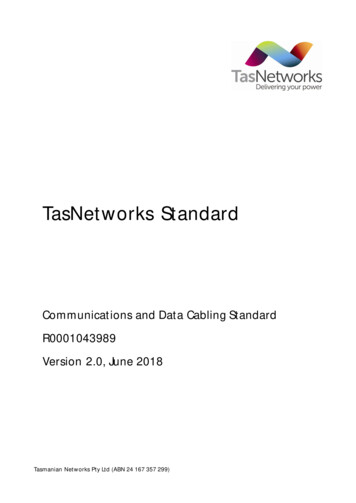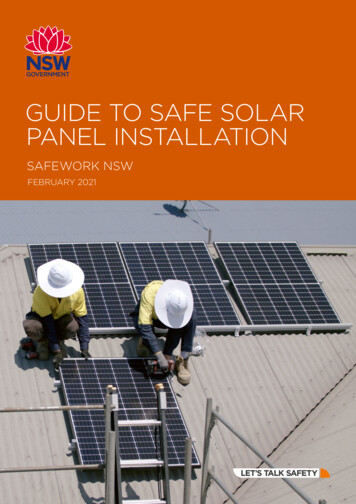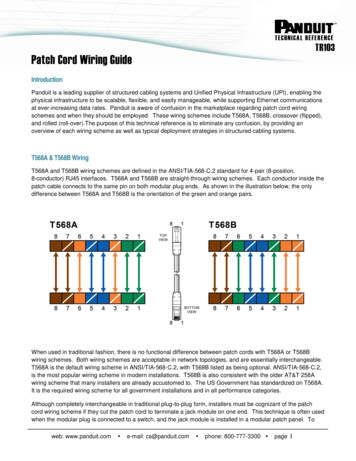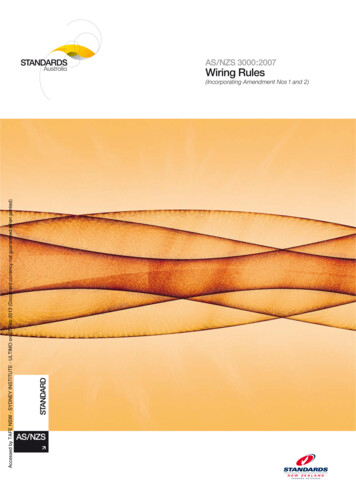
Transcription
Accessed by TAFE NSW - SYDNEY INSTITUTE - ULTIMO on 07 Feb 2013 (Document currency not guaranteed when printed)AS/NZS 3000:2007Wiring Rules(Incorporating Amendment Nos 1 and 2)AS/NZS
Accessed by TAFE NSW - SYDNEY INSTITUTE - ULTIMO on 07 Feb 2013 (Document currency not guaranteed when printed)Wiring Rules
AS/NZS 3000:2007This Joint Australian/New Zealand Standard was prepared by JointTechnical Committee EL-001, Wiring Rules. It was approved on behalf ofthe Council of Standards Australia on 19 October 2007 and on behalf of theCouncil of Standards New Zealand on 9 November 2007.This Standard was published on 12 November 2007.Accessed by TAFE NSW - SYDNEY INSTITUTE - ULTIMO on 07 Feb 2013 (Document currency not guaranteed when printed)The following are represented on Committee EL-001:Association of Consulting Engineers AustraliaAustralian Building Codes BoardAustralian Electrical and Electronic Manufacturers AssociationCanterbury Manufacturers Association New ZealandCommunications, Electrical and Plumbing UnionConsumers' Federation of AustraliaElectrical and Communications Association (Qld)Electrical Contractors Association of New ZealandElectrical Regulatory Authorities CouncilElectrical Safety Organisation (New Zealand)ElectroComms and Energy Utilities Industries Skills CouncilEnergy Networks AssociationEngineers AustraliaInstitute of Electrical InspectorsMinistry of Economic Development (New Zealand)National Electrical and Communications AssociationNew Zealand Council of EldersNew Zealand Electrical InstituteTelstra Corporation LimitedKeeping Standards up-to-dateStandards are living documents which reflect progress in science, technologyand systems. To maintain their currency, all Standards are periodicallyreviewed, and new editions are published. Between editions, amendmentsmay be issued. Standards may also be withdrawn. It is important that readersassure themselves they are using a current Standard, which should includeany amendments which may have been published since the Standard waspurchased.Detailed information about joint Australian/New Zealand Standards can befound by visiting the Standards Web Shop at www.saiglobal.com orStandards New Zealand web site at www.standards.co.nz and looking up therelevant Standard in the on-line catalogue.Alternatively, both organizations publish an annual printed Catalogue withfull details of all current Standards. For more frequent listings or notificationof revisions, amendments and withdrawals, Standards Australia andStandards New Zealand offer a number of update options. For informationabout these services, users should contact their respective national Standardsorganization.We also welcome suggestions for improvement in our Standards, andespecially encourage readers to notify us immediately of any apparentinaccuracies or ambiguities. Please address your comments to the ChiefExecutive of either Standards Australia or Standards New Zealand at theaddress shown on the back cover.This Standard was issued in draft form for comment as DR 06001 to DR 06010.
AS/NZS 3000:2007(Incorporating Amendment Nos 1 and 2)Accessed by TAFE NSW - SYDNEY INSTITUTE - ULTIMO on 07 Feb 2013 (Document currency not guaranteed when printed)Australian/New Zealand Standard Electrical installations(known as the Australian/New ZealandWiring Rules)Originated as part of AS CC1—1931.Previous edition AS/NZS 3000:2000.Fifth edition 2007.Reissued incorporating Amendment No. 1 (July 2009).Reissued incorporating Amendment No. 2 (December 2012).COPYRIGHT Standards Australia/Standards New ZealandAll rights are reserved. No part of this work may be reproduced orcopied in any form or by any means, electronic or mechanical,including photocopying, without the written permission of the publisher,unless permitted under the Copyright Act 1968 (Australia) or theCopyright Act 1994 (New Zealand).Jointly published by SAI Global Limited under licence from StandardsAustralia Limited, GPO Box 476, Sydney, NSW 2001 and by StandardsNew Zealand, Private Bag 2439, Wellington 6140.ISBN 0 7337 8391 0
AS/NZS 3000:20072PREFACEA1This Standard was prepared by the Joint Standards Australia/StandardsNew Zealand Committee EL-001, Wiring Rules, to supersede, inAustralia/New Zealand, AS/NZS 3000:2000, Electrical installations (knownas the Australian/New Zealand Wiring Rules).This Standard incorporates Amendment No. 1 (July 2009) and AmendmentNo. 2 (December 2012). The changes required by the Amendment areindicated in the text by a marginal bar and amendment number against theclause, note, table, figure or part thereof affected.The development of this Standard has been based on the followingconsiderations:Accessed by TAFE NSW - SYDNEY INSTITUTE - ULTIMO on 07 Feb 2013 (Document currency not guaranteed when printed)(a)Results of a survey of the electrical industry indicated that the industrywanted a document better suited to the present electrical regulatorystructure, which flows more logically, is easier to understand,reinstates much of the guidance information removed from the 2000edition and contains an increased level of diagrammatic representationof concepts, and more selected examples.(b)Experience gained in the application of the eleventh (2000) edition asexpressed to Standards Australia and Standards New Zealand.During preparation of this Standard, reference was made to IEC 60364,Electrical installations of buildings (all parts) and acknowledgment is madeof the assistance received from this source.The presentation of this edition differs from previous editions ofAS/NZS 3000 in that the Standard comprises two parts but with both partsbound as one document.Part 1 provides uniform essential elements that constitute the minimumregulatory requirements for a safe electrical installation.It also provides an alternative regulatory vehicle for Australian and NewZealand regulators seeking to move from the present prescription ofAS/NZS 3000 in electrical installation safety and licensing legislation.Part 1 satisfies the following objectives: It is generally complete in itself to avoid cross-referencing to Part 2. It may be called up in regulation as a separate Part or together withPart 2. It provides ‘high level’ safety performance outcomes/conditions withoutprescriptive work methods that demonstrate means of compliance. It establishes an enforcement link to Part 2. Failure to comply with awork method provision in Part 2 would breach high level safetyconditions of Part 1 unless an alternative mechanism is satisfied. It establishes the ‘deemed to comply’ status of Part 2, confirming thatinstallations that comply with Part 2 comply with high level safetyconditions of Part 1.
3AS/NZS 3000:2007 It establishes ‘deemed to comply’ status of AS/NZS 3018, relating tosimple domestic applications, and parts of other standards, confirmingcompliance with ‘high level’ safety conditions of Part 1. It maintains alignment with IEC 60364 developments at the level ofessential safety. It provides a mechanism for acceptance of alternative design andinstallation practices that are not addressed, or are inconsistent with,those given in the ‘deemed to comply’ Part 2. This mechanism isintended to apply where departures from the methods in Part 2 aresignificant rather than minor aspects that remain within the flexibility ofPart 2. It details responsibilities, documentation and verification criteria fordesigners or installers that seek to apply an alternative method to the‘deemed to comply’ methods contained in Part 2.Accessed by TAFE NSW - SYDNEY INSTITUTE - ULTIMO on 07 Feb 2013 (Document currency not guaranteed when printed)Part 2 provides installation practices that achieve certainty of compliancewith the essential safety requirements of Part 1.It is primarily a revision of the 2000 edition to provide work methods andinstallation practices that are ‘deemed to comply’ with the associatedperformance outcomes/safety conditions.Part 2 satisfies the following objectives: It may be called up in regulation in addition to Part 1 to reflect a rangeof regulatory adoption options. It incorporates and elaborates on all ‘high level’ performanceoutcomes of Part 1 with the addition of requirements andrecommendations to clarify and support compliance. It establishes the ‘deemed to comply’ status of AS/NZS 3018 relatingto simple domestic applications, and parts of other standards,confirming compliance with the work methods of Part 2 and the ‘highlevel’ safety conditions of Part 1. It generally retains the structure of AS/NZS 3000:2000, except thatVerification (inspection and testing) has been moved to the finalsection of substantive text as it would be the last function performed inthe formation of an electrical installation, and damp situations havebeen separated from other special electrical installations as they arethe more commonly occurring of special electrical installations. New introductory selection and installation clauses have been includedin Sections 2, 3, 4, 5, 6 and 7. It restores information from AS 3000—1991 as requirements,recommendations and examples of typical, effective compliantsolutions. Emphasis has been placed on common, practicable and cost-effectivemethods that achieve safety compliance, fitness for purpose and alevel of good practice rather than overly conservative or obscuremeasures.
AS/NZS 3000:20074 Greater use has been made of illustrations and examples to promoteunderstanding of common or difficult aspects, e.g. line diagrams,alternative overcurrent device locations, International Protection (IP)rating summary, switchboard access. Testing and inspection provisions have been updated in alignmentwith AS/NZS 3017, including provisions for periodic inspection inaccordance with AS/NZS 3019.Other major changes to the content of AS/NZS 3000:2000 include thefollowing:Accessed by TAFE NSW - SYDNEY INSTITUTE - ULTIMO on 07 Feb 2013 (Document currency not guaranteed when printed)(i)(ii)Revised or new definitions for— electrical installation; circuit; basic protection (protection against direct contact); fault protection (protection against indirect contact); outbuilding; isolation; and competent person.Requirements for alterations, additions and repairs have beenexpanded and clarified through the integration of information containedin a number of frequently asked questions.(iii) Illustration of normal and alternative location, and omission of,overcurrent devices.(iv) Discrimination/selectivity of protective devices.(v)A single main switch (per tariff) for a single domestic installation.(vi) Illustration of basic clearances for switchboard access.(vii) Expansion of the use of residual current devices (RCDs) to all socketoutlet and lighting circuits rated up to 20 A.(viii) Limiting the number of circuits connected to any one RCD to three.(ix) Requiring the division of lighting circuits between RCDs where thenumber of both RCDs and lighting circuits exceeds one.A2(x)Arc fault protection is required for all switchboards with a nominalsupply rated above 800 A. It is recommended for all otherswitchboards.(xi) Full-size neutral conductors are required on consumers mains,multiphase submain and final subcircuits subject to some conditions,for example overcurrent detection is fitted.(xii) Allowance for a voltage drop of up to 7% where a substation is locatedon the premises.(xiii) Installation couplers are recognised as a suitable method ofconnecting cables.
5AS/NZS 3000:2007(xiv) The colour identification of conductors has been clarified, particularlyfor European alternatives for single-phase and three-phaseapplications.(xv) Restrictions on cable supports in suspended ceilings.(xvi) Additional illustrations of the protection of wiring systems near buildingsurfaces have been included.(xvii) Segregation from telecommunications, gas and water services hasbeen clarified and a summary table of separation distances given.Accessed by TAFE NSW - SYDNEY INSTITUTE - ULTIMO on 07 Feb 2013 (Document currency not guaranteed when printed)A1(xviii) The location of underground cables must be marked at entry to orexit from a structure or recorded on a map.(xix)Aerial cable clearances have been updated to distribution industrystandards.(xx)Requirements have been added for the prevention of the spread offire.(xxi) Requirements for clearances of recessed luminaires to combustiblebuilding material and thermal insulation have been critically revised.(xxii) Electricity generating systems, such as engine-driven generator sets,stand-alone power systems, grid-connected inverter systems andbatteries, have been moved to Section 7.A1(xxiii) Illustrations of the multiple earthed neutral (MEN) system have beenimproved and clarification of the relationship of the MEN system to theIEC systems has been added.(xxiv) Earthing electrode types and installation conditions have beenspecified.(xxv) Main earthing conductors to be labelled at the connection to the earthelectrode.(xxvi) Requirements for MEN switchboards in outbuildings have beenclarified.(xxvii) Illustration of equipotential bonding of conductive water piping hasbeen included.(xxviii) Reinforced concrete slabs in a shower or bathroom must beequipotentially bonded.(xxix) Information on earth fault-loop impedance, previously included inSection 1, has been moved to Section 5.(xxx) Bath and shower figures have been corrected to fix the Zone 2discrepancy in the 2000 edition and now appear with correspondingplan and elevation views on facing pages.(xxxi) The Zone 1 horizontal dimension for spa pools and tubs with watercapacity less than 5 000 L has been increased to 1.25 m, instead of1.0 m. This dimension has been changed from AS/NZS 3000:2000 toalign with the limit of arm’s reach defined in Clause 1.4.12 andFigure 1.1.
AS/NZS 3000:20076(xxxii) In locations containing sauna heaters (Clause 6.5), Zone 4 (the300 mm below the ceiling) has been removed to align withIEC 60364-7-703. Zones 1 and 3 have been extended to incorporatethis area.(xxxiii) Sanitization operations have been added to hosing-down operationsto clearly cover food-handling and produce areas, such as chickenfarms, where corrosive chemicals are used in the cleaning and hosingdown process.(xxxiv) Hosing-down zones have been modified.(xxxv) ‘Emergency systems’ have been renamed ‘Safety services’ in linewith IEC 60364.Accessed by TAFE NSW - SYDNEY INSTITUTE - ULTIMO on 07 Feb 2013 (Document currency not guaranteed when printed)(xxxvi) Generating systems are dealt with in greater detail, particularly inthe areas of the suitability of RCDs with respect to waveforms of thesupply and to the connection to an electrical installation. Illustration isprovided for generator supply interconnection.(xxxvii) Electrical separation is dealt with in greater detail with a newrequirement for double pole switching, the provision of testingrequirements in addition to those of Section 8 and the inclusion ofillustrations.(xxxviii) Separation of extra-low voltage (ELV) circuits from live parts ofother circuits [both separated extra-low voltage (SELV) and protectedextra-low voltage (PELV)] and earth (SELV only) must be verified byinsulation resistance testing.A2(xxxix) The requirements for high voltage installations (Clause 7.6) havebeen substantially reduced and provide a pointer to AS 2067 and theNew Zealand Electricity (Safety) Regulations 2010.(xl) Reference to other Standards and documents has been clarified tohighlight their status. Specific electrical installation Standards are nowgrouped as—(A)providing additional requirements that have to be complied with;(B)deemed to comply Standards; and(C)Standards providing guidance for specific electrical installations.(xli) AS/NZS 3012, Electrical installations—Construction and demolitionsites, and AS/NZS 3003, Electrical installations—Patient areas ofhospitals and medical, dental practices and dialyzing locations, havebeen elevated from the status of guidance Standards to that ofStandards providing additional requirements that have to be compliedwith.(xlii) Verification of operation of RCDs where supply is connected is nowmandatory in Australia.A1(xliii) Verification of earth fault-loop impedance for socket-outlet circuits notprotected by an RCD is now a mandatory test for both Australia andNew Zealand.
7A2AS/NZS 3000:2007(xliv) The date of initial energization of an installation is required to beavailable on-site.Accessed by TAFE NSW - SYDNEY INSTITUTE - ULTIMO on 07 Feb 2013 (Document currency not guaranteed when printed)(xlv) Appendix B has been renamed ‘Circuit protection guide’ to reflect itscontent more accurately. It has been expanded to provide illustrationof circuit arrangements of an installation, guidance information onautomatic disconnection of supply as an introduction to the treatmentof earth fault-loop impedance and a better illustration of an MENsystem with earth fault-loop. Table B4.1 of the 2000 edition, Maximumvalues of earth fault-loop impedance (Z s) at 230 V a.c., has beenrelocated to Section 8 Verification.(xlvi) Appendix C has been expanded to cover more than the calculation ofmaximum demand and the information provided on maximum demandhas been clarified and updated. The Appendix has been renamed‘Circuit arrangements’ and includes guidance information on simplifiedcable current ratings, simplified voltage drop calculations, the numberof points connected to circuits and the number of cables that can beinstalled in conduits similar to that in the 1991 edition of AS 3000, butnot included in AS/NZS 3000:2000.(xlvii) Appendix D has been updated to provide more comprehensiveguidance information for the construction of private aerial lines.(xlviii) Appendix E has been added to provide some information on theelectrical requirements contained in National Building Codes (theBuilding Code of Australia (BCA) and the New Zealand Building Code(NZBC)).(xlix) Appendix F has been added to provide information and guidance onthe installation of surge protective devices (SPDs).(l)Appendix G has been added to provide information and guidance onthe degree of protection of enclosed equipment (InternationalProtection or IP rating).(li)Appendix H has been added to provide information and guidance onthe classification of wiring systems (WS classification).(lii) Appendix I has been added to provide information and guidance onthe ratings of overload protective devices where alterations, additionsor repairs involve the use of existing conductors of an imperial size.(liii) Appendix J has been added to provide a full listing of electricalsymbols used in this Standard.A2(liv) Text deleted(lv) An improved index has been provided to make using the documentmore intuitive.
AS/NZS 3000:20078(lvi) The electric shock survival (resuscitation) guide has been updated toincorporate current practice. It is, however, only provided for guidance.Persons associated with the installation and repair of electricalinstallations and electrical equipment should obtain training inresuscitation methods.This Standard may be applied through legislative requirements, asindicated in Clause 1.2. As this Standard supersedes AS/NZS 3000:2000, itwould usually apply to electrical installations from its date of publication, butit is recommended that it not be applied on a mandatory basis before a dateat least six months after publication. However, if work on an installation wascommenced before publication of this edition, the relevant regulatoryauthority or electricity distributor may grant permission for the installation tobe completed in accordance with AS/NZS 3000:2000.Accessed by TAFE NSW - SYDNEY INSTITUTE - ULTIMO on 07 Feb 2013 (Document currency not guaranteed when printed)Statements expressed in mandatory terms in notes to tables and figures aredeemed to be requirements of this Standard.The term, ‘informative’ has been used in this Standard to define theapplication of the appendix to which it applies. An ‘informative’ appendix isonly for information and guidance.
9AS/NZS 3000:2007CONTENTSPageFOREWORD . 19Accessed by TAFE NSW - SYDNEY INSTITUTE - ULTIMO on 07 Feb 2013 (Document currency not guaranteed when printed)Part 1: Scope, application and fundamental principlesSECTION 1 SCOPE, APPLICATION AND FUNDAMENTAL PRINCIPLES1.1 SCOPE . 211.2 APPLICATION . 211.3 REFERENCED DOCUMENTS . 221.4 DEFINITIONS . 221.5 FUNDAMENTAL PRINCIPLES . 391.6 DESIGN OF AN ELECTRICAL INSTALLATION . 511.7 SELECTION AND INSTALLATION OF ELECTRICALEQUIPMENT . 521.8 VERIFICATION (INSPECTION AND TESTING) . 541.9 MEANS OF COMPLIANCE. 54Part 2: Installation practices—Sections 2 to 8SECTION 2 GENERAL ARRANGEMENT, CONTROL AND PROTECTION2.1 GENERAL . 582.2 ARRANGEMENT OF ELECTRICAL INSTALLATION . 582.3 CONTROL OF ELECTRICAL INSTALLATION. 622.4 FAULT PROTECTION . 742.5 PROTECTION AGAINST OVERCURRENT . 752.6 ADDITIONAL PROTECTION BY RESIDUAL CURRENTDEVICES . 982.7 PROTECTION AGAINST OVERVOLTAGE . 1052.8 PROTECTION AGAINST UNDERVOLTAGE . 1062.9 SWITCHBOARDS . 107SECTION 3 SELECTION AND INSTALLATION OF WIRING SYSTEMS3.1 GENERAL . 1203.2 TYPES OF WIRING SYSTEMS . 1203.3 EXTERNAL INFLUENCES . 1233.4 CURRENT-CARRYING CAPACITY . 1263.5 CONDUCTOR SIZE . 1293.6 VOLTAGE DROP . 1313.7 ELECTRICAL CONNECTIONS . 1323.8 IDENTIFICATION . 1363.9 INSTALLATION REQUIREMENTS . 1403.10 ENCLOSURE OF CABLES. 1563.11 UNDERGROUND WIRING SYSTEMS . 1593.12 AERIAL WIRING SYSTEMS . 1683.13 CABLES SUPPORTED BY A CATENARY . 174
AS/NZS 3000:200710PageAccessed by TAFE NSW - SYDNEY INSTITUTE - ULTIMO on 07 Feb 2013 (Document currency not guaranteed when printed)3.14 SAFETY SYSTEMS . 1743.15 BUSWAYS, INCLUDING RISING MAINS SYSTEMS . 1743.16 EARTH SHEATH RETURN (ESR) SYSTEM . 175SECTION 4 SELECTION AND INSTALLATION OF APPLIANCES ANDACCESSORIES4.1 GENERAL . 1764.2 PROTECTION AGAINST THERMAL EFFECTS . 1784.3 CONNECTION OF ELECTRICAL EQUIPMENT . 1814.4 SOCKET-OUTLETS . 1844.5GHTING EQUIPMENT AND ACCESSORIES . 1874.6 SMOKE AND FIRE DETECTORS . 1954.7 COOKING APPLIANCES . 1954.8 APPLIANCES PRODUCING HOT WATER OR STEAM . 1964.9 ROOM HEATERS. 1974.10 ELECTRIC HEATING CABLES FOR FLOORS ANDCEILINGS AND TRACE HEATING APPLICATIONS . 1974.11 ELECTRIC DUCT HEATERS . 1994.12 ELECTRICITY CONVERTERS . 1994.13 MOTORS. 2034.14 TRANSFORMERS. 2064.15 CAPACITORS . 2074.16 ELECTRICAL EQUIPMENT CONTAINING LIQUIDDIELECTRICS . 2094.17 BATTERIES . 210SECTION 5 EARTHING ARRANGEMENTS AND EARTHINGCONDUCTORS5.1 GENERAL . 2135.2 EARTHING FUNCTIONS . 2175.3 EARTHING SYSTEM PARTS . 2185.4 EARTHING OF EQUIPMENT . 2305.5 EARTHING ARRANGEMENTS . 2345.6 EQUIPOTENTIAL BONDING . 2425.7 EARTH FAULT-LOOP IMPEDANCE . 2505.8 OTHER EARTHING ARRANGEMENTS . 252SECTION 6 DAMP SITUATIONS6.1 GENERAL . 2536.2 BATHS, SHOWERS AND OTHER FIXED WATERCONTAINERS . 2546.3 SWIMMING POOLS, PADDLING POOLS AND SPA POOLSOR TUBS . 2706.4 FOUNTAINS AND WATER FEATURES . 2806.5 SAUNAS . 2856.6 REFRIGERATION ROOMS . 2896.7 SANITIZATION AND GENERAL HOSING-DOWNOPERATIONS . 291
11AS/NZS 3000:2007PageAccessed by TAFE NSW - SYDNEY INSTITUTE - ULTIMO on 07 Feb 2013 (Document currency not guaranteed when printed)SECTION 7 SPECIAL ELECTRICAL INSTALLATIONS7.1 GENERAL . 2937.2 SAFETY SERVICES . 2947.3 ELECTRICITY GENERATION SYSTEMS . 3047.4 ELECTRICAL SEPARATION (ISOLATED SUPPLY) . 3157.5 EXTRA-LOW VOLTAGE ELECTRICALINSTALLATIONS . 3207.6 HIGH VOLTAGE ELECTRICAL INSTALLATIONS . 3247.7 HAZARDOUS AREAS (EXPLOSIVE GAS ORCOMBUSTIBLE DUSTS) . 3267.8 SPECIFIC ELECTRICAL INSTALLATION STANDARDS . 326SECTION 8 VERIFICATION8.1 GENERAL . 3308.2 VISUAL INSPECTION . 3318.3 TESTING . 3338.4 DATE OF INITIAL ENERGISATION OF ANINSTALLATION . 342A1APPENDICESAREFERENCED DOCUMENTS . 343BCIRCUIT PROTECTION GUIDE . 351CCIRCUIT ARRANGEMENTS . 366DMINIMUM SIZES OF POSTS, POLES AND STRUTSFOR AERIAL LINE CONDUCTORS . 401EELECTRICAL INSTALLATION REQUIREMENTS INNATIONAL BUILDING CODES . 420FINSTALLATION OF SURGE PROTECTIVE DEVICES . 425GDEGREES OF PROTECTION OF ENCLOSEDEQUIPMENT . 430HWS CLASSIFICATION OF WIRING SYSTEMS . 435IPROTECTIVE DEVICE RATINGS AND METRICEQUIVALENT SIZES FOR IMPERIAL CABLES USEDIN ALTERATIONS ADDITIONS AND REPAIRS . 443JSYMBOLS USED IN THIS STANDARD . 446K(Deleted)LELECTRIC SHOCK SURVIVAL—Australia . 449MELECTRIC SHOCK SURVIVAL—New Zealand . 451INDEX . 446
AS/NZS 3000:200712LIST OF TABLESPage3.13.23.33.4Accessed by TAFE NSW - SYDNEY INSTITUTE - ULTIMO on 07 Feb 2013 (Document currency not guaranteed when 2B1C1C2C3C4CABLE TYPES AND THEIR APPLICATION IN WIRINGSYSTEMS . 122LIMITING TEMPERATURES FOR INSULATED CABLES . 127NOMINAL MINIMUM CROSS-SECTIONAL AREA
AS/NZS 3000:2007 2 PREFACE This Standard was prepared by the Joint Standards Australia/Standards New Zealand Committee EL-001, Wiring Rules, to supersede, in Australia/New Zealand, AS/NZS 3000:2000, Electrical installations (known as the Australian/New Zealand Wiring Rules). This Standard incorporates Amendment No. 1 (July 2009) and
